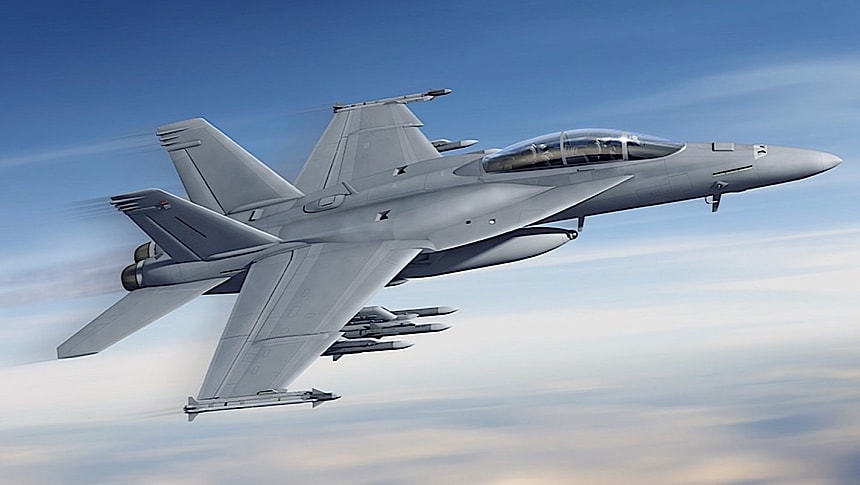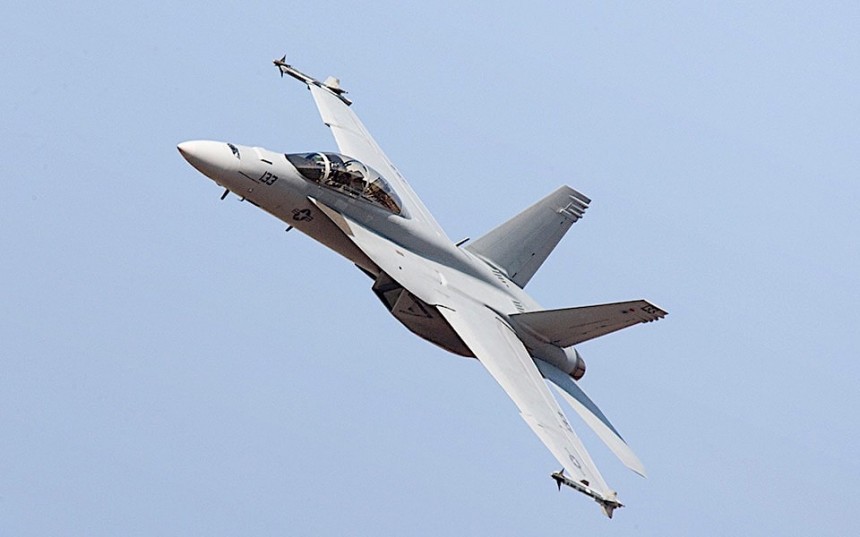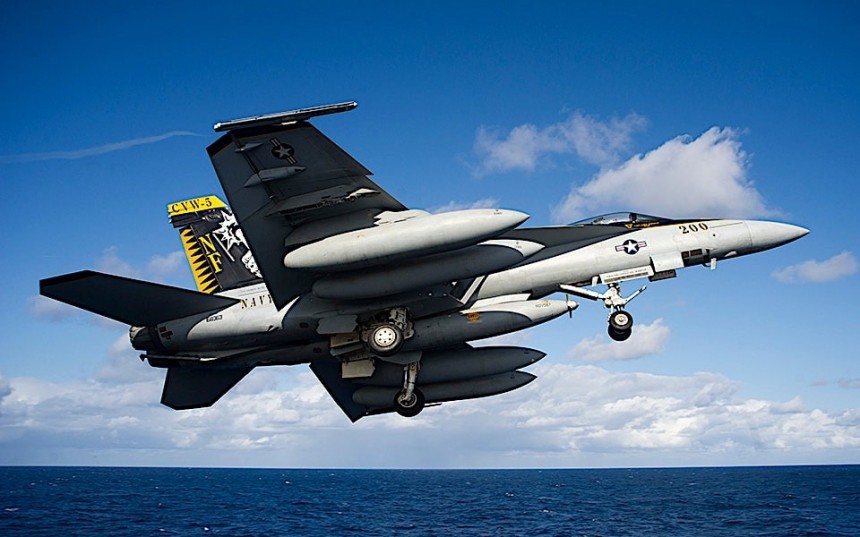American aerospace giant Boeing is at the center of attention these days for all the wrong reasons, but that doesn't mean there aren't aspects of the business that don't go as planned. Like, say, the company's work on keeping the U.S. Navy F/A-18 Block III Super Hornets up, running, and updated.
The Super Hornet is built on one of the most successful aerial platforms ever flown by the Navy. Born at the hands of the now-defunct McDonnell Douglas all the way back in 1983 as the F/A-18 Hornet and meant to replace the F-14 Tomcat, the plane later spawned two more variants, the F/A-18 Super Hornet (introduced in 1995) and EA-18G Growler (available since 2006), both of them capable of launching off the decks of aircraft carriers.
Like many of the military aircraft currently in operation, the F/A-18 Super Hornet is thus quite old, but that doesn't mean it's the same kind of machine that rolled off the assembly lines four decades ago. A series of upgrades have kept it relevant to the modern day, and that will continue to happen in the foreseeable future.
The current fleet of Navy Super Hornets are of the Block II variety. The variant has been around since 2001 and comes with a series of improvements over the base plane, including the Active Electronically Scanned Array (AESA) radar, increased range, and improved sensors and avionics.
The last Block II plane entered service with the Navy in 2020, and already its present maker, Boeing, is hard at work coming up with even more improvements, all of them meant to keep the plane running for years to come.
Called Block III, the current modernization effort targets a series of capabilities, ranging from the fitting of a more advanced cockpit system and reduced radar cross-section to an advanced networking infrastructure and more powerful computing.
Block III Super Hornets, the "safest and most capable" of their kind, were born back in 2020 as a couple of test planes. Back then, the Navy awarded Boeing a contract to deliver 78 new-build F/A-18 Block III jets by the end of 2024. We don't know how that order is going, but in parallel with building new planes, the company is also offering the Block III upgrades as service life modifications for existing Super Hornets.
The aerospace giant says the "upgraded jets have the same capabilities as Super Hornets being delivered from Boeing's new-build production line," but I guess the Navy will find that out on its own soon: at the end of June the first two planes from this batch were delivered.
The military branch got the planes up to two months ahead of schedule, but work on others is just beginning, as Boeing has "around 15 years of SLM deliveries to go." The company is modifying the planes in two locations, St. Louis and San Antonio, with the Navy's Fleet Readiness Center Southwest in San Diego also being involved.
The modifications made to the Super Hornets by Boeing are not the only upgrades being planned. On the weapons' front the jets are getting ready to field a new mighty punch, in the form of the StormBreaker.
Previously known as the Small Diameter Bomb-II, or the GBU-53/B, the air-launched precision-guided bomb is produced by defense contractor Raytheon and has the ability to change direction mid-flight, hitting targets located 40 miles (64 km) away from where it was launched.
Separately, the Super Hornets are also getting from the same Raytheon an Advanced Electronic Warfare system. The tech is meant to replace the current setup, which comprises an integrated defensive electronic countermeasure system called AN/ALQ-214 and a radar warning receiver, the AN/ALR-67(V)3.
What does not change is the plane's powertrain. The Super Hornet is powered by a pair of General Electric turbofan engines capable of generating 22,000 pounds of thrust each.
The powerplants are more than enough to allow the plane to reach top speeds of Mach 1.8 (1,381 mph/2,222 kph), while its fuel tanks allow it to operate on a distance of as much as 1,457 miles (2,346 km) when carrying just a couple of AIM-9 Sidewinder missiles.
The era of the Super Hornet will however soon come to an end. At the beginning of last year, Boeing announced it would stop making the plane for the U.S. Navy in 2027 (the initial deadline was 2025, but a final order from the Navy delayed that).
The reason for the production stop is in no small part owed to the fact that, no matter how many upgrades are performed, only so much can be done to the plane to keep it relevant in today's world.
To date, numbers show some 2,000 Hornets were made, 600 of them Super Hornets. They are shared by the U.S. with allied nations, including Australia and Kuwait. It's likely production for overseas use will stop as well, especially given how the last hope to keep the lines rolling, a potential order from India, was killed when the country opted to go for the French Dassault Rafale-M.
Like many of the military aircraft currently in operation, the F/A-18 Super Hornet is thus quite old, but that doesn't mean it's the same kind of machine that rolled off the assembly lines four decades ago. A series of upgrades have kept it relevant to the modern day, and that will continue to happen in the foreseeable future.
The current fleet of Navy Super Hornets are of the Block II variety. The variant has been around since 2001 and comes with a series of improvements over the base plane, including the Active Electronically Scanned Array (AESA) radar, increased range, and improved sensors and avionics.
The last Block II plane entered service with the Navy in 2020, and already its present maker, Boeing, is hard at work coming up with even more improvements, all of them meant to keep the plane running for years to come.
Called Block III, the current modernization effort targets a series of capabilities, ranging from the fitting of a more advanced cockpit system and reduced radar cross-section to an advanced networking infrastructure and more powerful computing.
The aerospace giant says the "upgraded jets have the same capabilities as Super Hornets being delivered from Boeing's new-build production line," but I guess the Navy will find that out on its own soon: at the end of June the first two planes from this batch were delivered.
The military branch got the planes up to two months ahead of schedule, but work on others is just beginning, as Boeing has "around 15 years of SLM deliveries to go." The company is modifying the planes in two locations, St. Louis and San Antonio, with the Navy's Fleet Readiness Center Southwest in San Diego also being involved.
The modifications made to the Super Hornets by Boeing are not the only upgrades being planned. On the weapons' front the jets are getting ready to field a new mighty punch, in the form of the StormBreaker.
Previously known as the Small Diameter Bomb-II, or the GBU-53/B, the air-launched precision-guided bomb is produced by defense contractor Raytheon and has the ability to change direction mid-flight, hitting targets located 40 miles (64 km) away from where it was launched.
Separately, the Super Hornets are also getting from the same Raytheon an Advanced Electronic Warfare system. The tech is meant to replace the current setup, which comprises an integrated defensive electronic countermeasure system called AN/ALQ-214 and a radar warning receiver, the AN/ALR-67(V)3.
The powerplants are more than enough to allow the plane to reach top speeds of Mach 1.8 (1,381 mph/2,222 kph), while its fuel tanks allow it to operate on a distance of as much as 1,457 miles (2,346 km) when carrying just a couple of AIM-9 Sidewinder missiles.
The era of the Super Hornet will however soon come to an end. At the beginning of last year, Boeing announced it would stop making the plane for the U.S. Navy in 2027 (the initial deadline was 2025, but a final order from the Navy delayed that).
The reason for the production stop is in no small part owed to the fact that, no matter how many upgrades are performed, only so much can be done to the plane to keep it relevant in today's world.
To date, numbers show some 2,000 Hornets were made, 600 of them Super Hornets. They are shared by the U.S. with allied nations, including Australia and Kuwait. It's likely production for overseas use will stop as well, especially given how the last hope to keep the lines rolling, a potential order from India, was killed when the country opted to go for the French Dassault Rafale-M.























